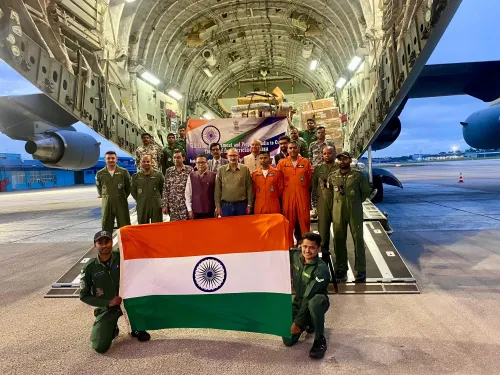Are Efforts to Save Northern White Rhinos from Extinction at an Advanced Stage?

Synopsis
Key Takeaways
- The Northern White Rhino is critically endangered with only two females remaining.
- The Kenya Wildlife Service is collaborating with the BioRescue consortium.
- Innovative Assisted Reproduction Technologies are being employed.
- Success in achieving pregnancies could save the subspecies.
- Conservation efforts have been ongoing since 2019.
Nairobi, July 18 (NationPress) The Kenya Wildlife Service (KWS) announced on Friday that its initiatives to save the Northern White Rhinos (NWR), a critically endangered subspecies, from extinction via artificial fertilization have reached a pivotal phase.
The KWS is partnering with global collaborators in the BioRescue consortium to harness cutting-edge Assisted Reproduction Technologies (ART), including in Vitro Fertilization (IVF) and embryo transfer methods.
After the passing of the last male NWR in 2018, the BioRescue consortium is now investigating ART techniques using the only two remaining females, Najin and her offspring Fatu, who are both cared for at the Ol Pejeta Conservancy in Laikipia County, Central Kenya, as stated in a press release from the KWS.
“Following years of detailed research and refinement of our techniques, we are now at a critical moment in achieving a pregnancy with northern white rhino embryos,” said KWS Director-General Erustus Kanga.
The ART procedure includes extracting eggs from Najin and Fatu, airlifting the eggs to the Avantea laboratory in Cremona, Italy within a vital 24-hour period for maturation into ovum, and utilizing cryopreserved sperm from deceased NWR males to create embryos that will later be implanted into surrogate Southern White Rhinos (SWRs) to support a pregnancy.
Kanga noted that they have already successfully demonstrated a proof of concept by inducing a pregnancy in a surrogate using a SWR embryo.
The BioRescue project, which represents the final hope for this functionally extinct subspecies, has successfully produced several pure NWR embryos that are currently preserved in cryogenic storage for future transfer, according to the KWS.
The KWS indicated that the endeavor to preserve the NWRs commenced earnestly in 2019, building upon decades of conservation work, including the 2009 relocation of the last four fertile NWRs from Zoo Dvur Kralove in the Czech Republic to the Ol Pejeta Conservancy.
“With the demise of the last two males, Sudan and Suni, the hope for the future now hinges entirely on science and the two surviving females, Najin and her daughter Fatu,” the agency remarked.









